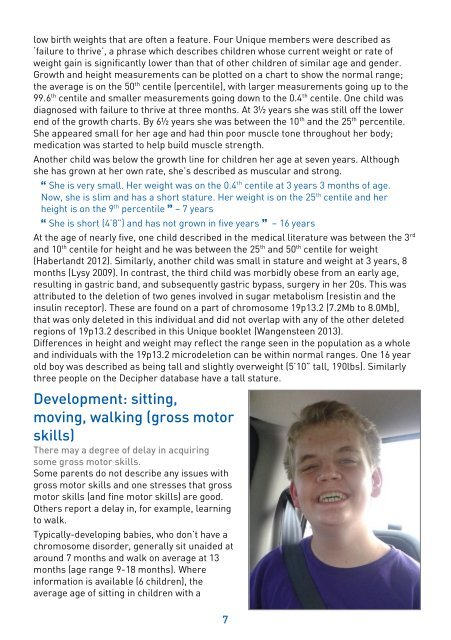19p13.2 microdeletions - Unique The Rare Chromosome Disorder ...
19p13.2 microdeletions - Unique The Rare Chromosome Disorder ...
19p13.2 microdeletions - Unique The Rare Chromosome Disorder ...
You also want an ePaper? Increase the reach of your titles
YUMPU automatically turns print PDFs into web optimized ePapers that Google loves.
low birth weights that are often a feature. Four <strong>Unique</strong> members were described as<br />
‘failure to thrive’, a phrase which describes children whose current weight or rate of<br />
weight gain is significantly lower than that of other children of similar age and gender.<br />
Growth and height measurements can be plotted on a chart to show the normal range;<br />
the average is on the 50 th centile (percentile), with larger measurements going up to the<br />
99.6 th centile and smaller measurements going down to the 0.4 th centile. One child was<br />
diagnosed with failure to thrive at three months. At 3½ years she was still off the lower<br />
end of the growth charts. By 6½ years she was between the 10 th and the 25 th percentile.<br />
She appeared small for her age and had thin poor muscle tone throughout her body;<br />
medication was started to help build muscle strength.<br />
Another child was below the growth line for children her age at seven years. Although<br />
she has grown at her own rate, she’s described as muscular and strong.<br />
She is very small. Her weight was on the 0.4 th centile at 3 years 3 months of age.<br />
Now, she is slim and has a short stature. Her weight is on the 25 th centile and her<br />
height is on the 9 th percentile – 7 years<br />
She is short (4’8”) and has not grown in five years – 16 years<br />
At the age of nearly five, one child described in the medical literature was between the 3 rd<br />
and 10 th centile for height and he was between the 25 th and 50 th centile for weight<br />
(Haberlandt 2012). Similarly, another child was small in stature and weight at 3 years, 8<br />
months (Lysy 2009). In contrast, the third child was morbidly obese from an early age,<br />
resulting in gastric band, and subsequently gastric bypass, surgery in her 20s. This was<br />
attributed to the deletion of two genes involved in sugar metabolism (resistin and the<br />
insulin receptor). <strong>The</strong>se are found on a part of chromosome <strong>19p13.2</strong> (7.2Mb to 8.0Mb),<br />
that was only deleted in this individual and did not overlap with any of the other deleted<br />
regions of <strong>19p13.2</strong> described in this <strong>Unique</strong> booklet (Wangensteen 2013).<br />
Differences in height and weight may reflect the range seen in the population as a whole<br />
and individuals with the <strong>19p13.2</strong> microdeletion can be within normal ranges. One 16 year<br />
old boy was described as being tall and slightly overweight (5’10” tall, 190lbs). Similarly<br />
three people on the Decipher database have a tall stature.<br />
Development: sitting,<br />
moving, walking (gross motor<br />
skills)<br />
<strong>The</strong>re may a degree of delay in acquiring<br />
some gross motor skills.<br />
Some parents do not describe any issues with<br />
gross motor skills and one stresses that gross<br />
motor skills (and fine motor skills) are good.<br />
Others report a delay in, for example, learning<br />
to walk.<br />
Typically-developing babies, who don’t have a<br />
chromosome disorder, generally sit unaided at<br />
around 7 months and walk on average at 13<br />
months (age range 9-18 months). Where<br />
information is available (6 children), the<br />
average age of sitting in children with a<br />
7
















